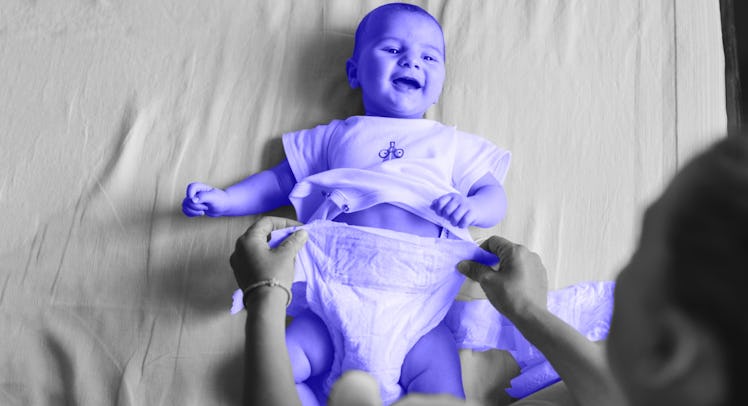The Anatomy and Functions of a Standard Baby Diaper
There's a lot more to a standard baby diaper than just a place where a kid can poop and pee. These are the features that make a parent's life better.

Parents take disposable diapers for granted. This is understandable, considering they go through a seemingly endless array of them throughout infancy and toddlerhood. But the disposable diaper is a miracle of modern science: Not only has it experienced a fascinating evolution, from the first old-school cloth that managed to somehow make poop manageable, but their construction is also a small-scale engineering marvel.
Diapers can be broken down into two main components, each with more features than one might consider when changing the fifth nearly blowout diaper of the day: the core and the chassis.
RELATED: Baby Change-N-Go Is A Portable Changing Table That Hangs On The Bathroom Stall Door
The core represents the center of the diaper. It includes a top sheet, the thin layer that touches baby’s butt and works as something of a magic mirror, allowing liquid to pass through but minimizing it from coming back out. Underneath that is the acquisition layer, which is where the real science kicks in: this layer absorbs urine and redistributes it into the diaper, creating that droopy mass, in what is typically referred to as an absorbent core. Within the core, a complex interaction of chemicals occurs, that is specifically designed to keep babies dry and pee off the carpet. It’s also what creates those handy blue lines that indicate that a diaper is wet.
“The gel is made up of Super Absorbent Polymers (SAPs). When dry, the SAPs are small granules that look like table sugar. When the diaper is wet, it turns blue because of a change in pH-balance and become a durable gel that locks liquid away to help avoid rewet and keep baby dry,” says Sara Giovanni, a scientist at Pampers. “The core can retain up to 30 times its weight in liquid, locking it away to help prevent wetness from coming back to the surface of the diaper and help keep babies drier.”
Meanwhile, the chassis serves myriad functions, each specifically designed to prevent disasters. The backsheet — that polyethylene layer on the outside — is what keeps absorbed liquids at bay while still allowing air to flow through. And the closures — or fasteners — form a complex machine that does more than just keep the diaper on.
“The closures are created with baby’s every move in mind and from soft, breathable materials that move with the baby as he plays and sleeps each day,” says Giovanni. “The closures consist of elastics that are stretchy to provide flexibility and improved fit, paired with simple adhesives, tucked away from baby’s skin, to keep materials in place and ensure diaper content stays inside.”
ALSO: 10 Essential Diaper Changing Tips for New Parents
Even the frills on the legs feature dual functionality: they help the baby stay mobile and comfortable while preventing chafing, and also help prevent leakage as long as they are adjusted accordingly.
“When a diaper fits well, it should appear straight and equally proportioned on your baby, and that includes leg cuffs. When positioned correctly, the leg cuffs can help prevent leakage – however, when the cuffs are tucked inside of the diaper, this is actually a common cause of leakage,” says Giovanni. “To perfectly position the diaper and cuffs, wrap the diaper neatly around your baby’s legs and bottom. After putting on the diaper, run your fingers around these edges to make sure the cuffs are pulled out.”
To the untrained eye, the changes that occur with different types of diapers as a child grows are simply changes in mass: As the kid grows, the diaper gets bigger. In fact, there’s a lot more to a diaper’s sizing and than simply getting bigger.
“We know that as baby grows, it’s important to find the perfect fit in a diaper to avoid leaks and ensure comfort,” says Giovanni. “That’s why different diapers have different and unique features and are available in different sizes.”
RELATED: The 8 Coolest Backpack Diaper Bags For Dads
It’s the little alterations that make all the difference: A groove cut out in swaddling-age children’s diapers to prevent irritating the remnants of the umbilical cord. Looser cuffs and waist for older children who are running but potty not trained. Some companies even develop different diapers for premature children.
Which is all to say, whether parents opt for bamboo-based organic diapers, the offerings of Big Diaper, or something in between, there’s a lot more going on inside those little packages than a place for baby to do their business.
This article was originally published on